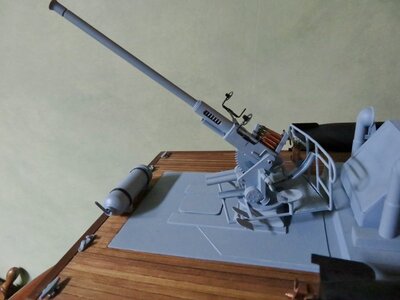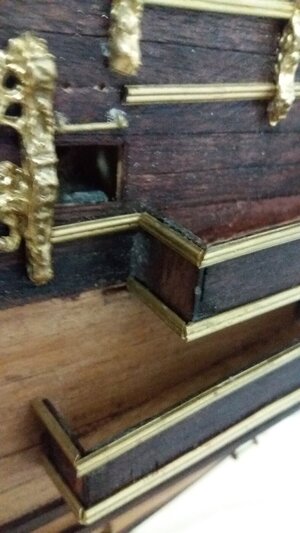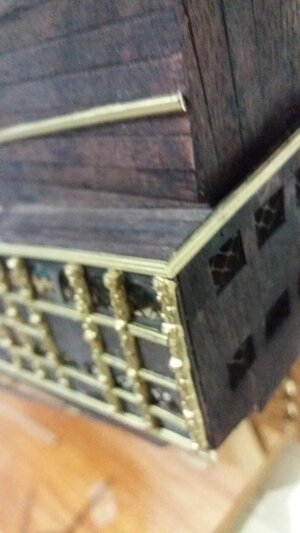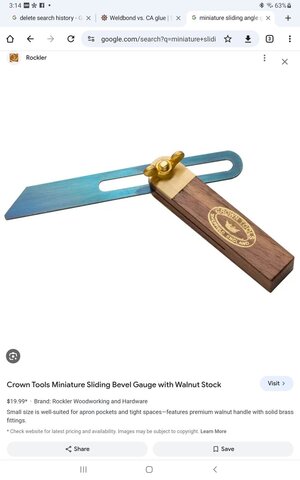You are using an out of date browser. It may not display this or other websites correctly.
You should upgrade or use an alternative browser.
You should upgrade or use an alternative browser.
I usually rely on very careful filing of the ends, and lots of test fitting, It's a slow process. If you fill the gaps in the ends of your miters with some filler and paint over those areas with touch of quality gold paint, you can disguise those discontinuities and make the work look better, especially from at a distance.
I would for sure use electric disk grinder. It is not possible doing this job without it.
Купи краску TAMIYA X- 12,ей заполняеш зазоры излишки снять тканью, повторить пару раз, и будет нормально.
They need to be mitered. Choose a method to carefully mark the angle, then as YT indicated, use a grinder to set the angle. If the angles are not going to be 45° but something other than for a square corner, first work the joint with wood scrap pieces to then be copied to the brass.Hi does anyone have a good way to make clean corner joints with brass moulding strips? Its easy in wood but getting the joints invisible is proving impossible. I'm doing yhe 80s Mantua Sovreign of the Seas. See pic. Thanks
View attachment 404582
View attachment 404583
Last edited:
I set up a jig made up at the proper angle to solder brass parts. The jig has to be made out of wood, as a metal one would transfer my heat away from my part to be soldered. Unfortunately the jig does get scorched a bit as I always use a small torch for heat as my hand on an electric iron always causes a misalignment of the parts. I use a tiny paint brush and a liquid flux to paint the joint ensuring that the solder will stay exactly where I want it. These photos show the principal I used to make brass boxes for navigation lights on my current project. In this case the wooden jig was 90 degrees, but could be made to fit anything you needed. Also the tiny bit of solder can easily be filed to clean up the joint for painting.
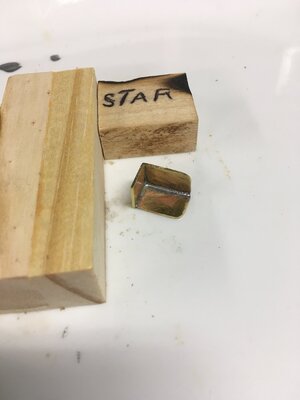
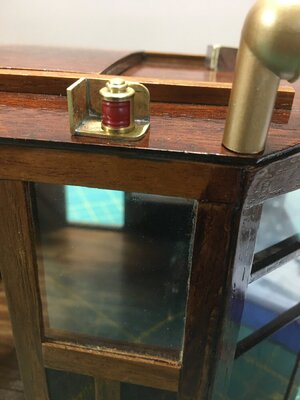


Thanks! what do you use for filler?I usually rely on very careful filing of the ends, and lots of test fitting, It's a slow process. If you fill the gaps in the ends of your miters with some filler and paint over those areas with touch of quality gold paint, you can disguise those discontinuities and make the work look better, especially from at a distance.
Yes, I've worn out files and fingers!I would for sure use electric disk grinder. It is not possible doing this job without it.
Спасибо большое, я попробую.Купи краску TAMIYA X- 12,ей заполняеш зазоры излишки снять тканью, повторить пару раз, и будет нормально.
Thanks--I agree it's the mitering process that's the issue--none are 45 degrees or vertical and because some have joints at both ends, at least one piece needs to be attached to the ship before continuing which limits the ability to refine the mitering--getting it just right without going to far is a constant challenge, so as Darivs says it's a slow process. If I knew then what I know now, I'd have made them myself out of timber!They need to be mitered. Choose a method to carefully mark the angle, the as YT indicated, use a grinder to set the angle. If the angles are not going to be 45° but something other than for a square corner, first work the joint with wood scrap pieces to then be copied to the brass.
Thanks! Beautiful work--would love to see the entire ship!I set up a jig made up at the proper angle to solder brass parts. The jig has to be made out of wood, as a metal one would transfer my heat away from my part to be soldered. Unfortunately the jig does get scorched a bit as I always use a small torch for heat as my hand on an electric iron always causes a misalignment of the parts. I use a tiny paint brush and a liquid flux to paint the joint ensuring that the solder will stay exactly where I want it. These photos show the principal I used to make brass boxes for navigation lights on my current project. In this case the wooden jig was 90 degrees, but could be made to fit anything you needed. Also the tiny bit of solder can easily be filed to clean up the joint for painting.
View attachment 404741
View attachment 404742
You can use any filler you want since you will paint it over. Using a filler which is sandable with a small sanding stick will allow you to blend the filler to the metal surfaces perfectly.Thanks! what do you use for filler?
Thanks!You can use any filler you want since you will paint it over. Using a filler which is sandable with a small sanding stick will allow you to blend the filler to the metal surfaces perfectly.
I set up a jig made up at the proper angle to solder brass parts. The jig has to be made out of wood, as a metal one would transfer my heat away from my part to be soldered. Unfortunately the jig does get scorched a bit as I always use a small torch for heat as my hand on an electric iron always causes a misalignment of the parts. I use a tiny paint brush and a liquid flux to paint the joint ensuring that the solder will stay exactly where I want it. These photos show the principal I used to make brass boxes for navigation lights on my current project. In this case the wooden jig was 90 degrees, but could be made to fit anything you needed. Also the tiny bit of solder can easily be filed to clean up the joint for painting.
View attachment 404741
View attachment 404742
Thanks! I actually have one of those but never thought to use it for this application. (See https://shipsofscale.com/sosforums/...le-modeling-tools.12817/page-3#post-336969):DAnother item you can try is a miniature sliding bevel gauge. It can be used to capture the angle and then a protractor to measure and divide. Rockler makes one just right for modelling.View attachment 404808
To do a proper job of any soldering your pieces must be clean at the joint with as close as you can get to the proper angle, and the pieces must be touching. What you are trying to do is not that difficult with accurate measurement and like Philski says proper angle. This is a 40 MM Bofors Gun 1/32 scale that I made entirely out of brass for my PT boat.
